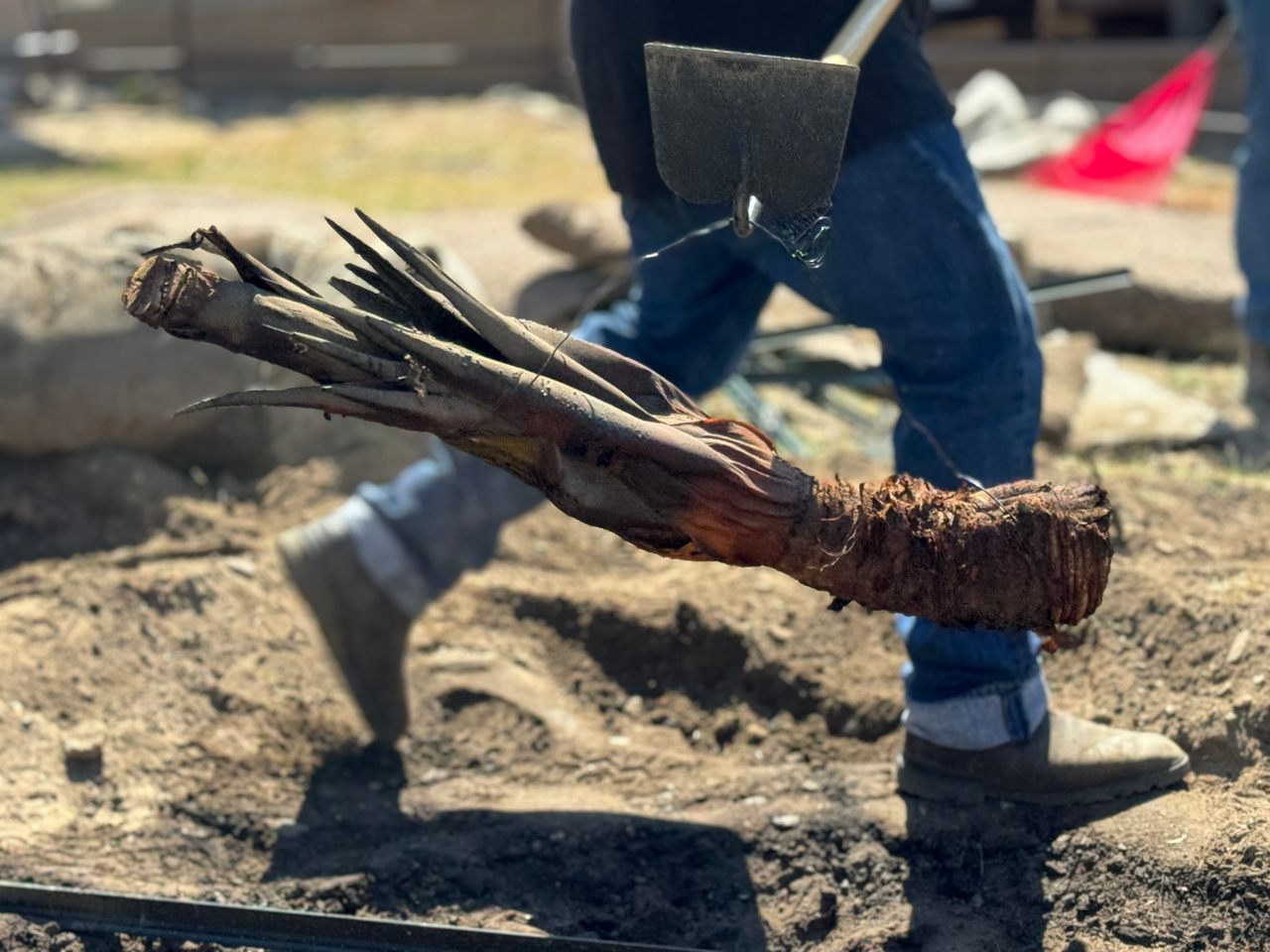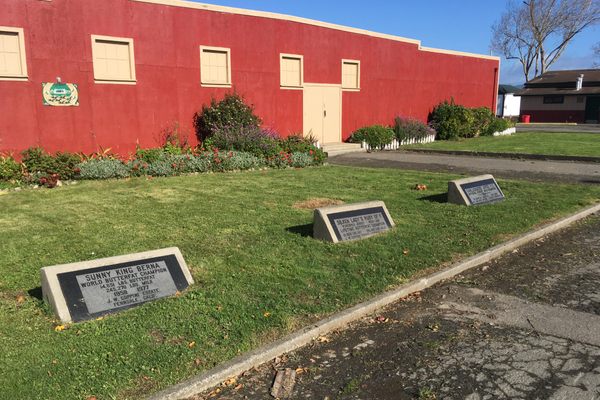The Indigenous Communities Preserving the Ancient Art of Roasting Agave
Now more famous as a distilling ingredient, agave has been a traditional food in Southern California for millennia.

Just as the Earth is waking up from winter, mature agave send flower stalks toward the sky. It signals the moment when the plant is at its most calorically dense. While many might associate agave with distilling, it is also a seasonal food, one of the earliest fresh foods that was available to the Indigenous people of the Mojave Desert. The Cahuilla of Southern California have been gathering and roasting agave hearts for at least 3,000 years, if not since time immemorial. The hearts are the base of a stalk just above the root ball, a little under a foot long and about four inches wide. Harvesting and cooking agave—ámul in Cahuilla, or Agave deserti—was both a necessary food tradition and a ritual celebration of the start of spring. Some tribal nations still celebrate this important turning of the seasons, including the Morongo Band of Mission Indians. Their annual Agave Roast Native Food Tasting event takes place every April at the Malki Museum and is open to the general public. And after years of wanting to attend, this spring I made the trip.

The Morongo Reservation is a 35,000-acre sovereign nation nestled between the San Gorgonio and San Jacinto Mountains, near Banning, California. It is the traditional homeland of the Cahuilla people, but over time, the area became home to people from eight different tribes. Perhaps it was this diversity that led two Cahuilla women, Jane Pablo Penn and Dr. Katherine Siva Saubel, to establish the Malki Museum in 1964, the first nonprofit Native American museum on a California reservation. The museum also started an academic publishing press the following year. Malki Press is still known as one of the world’s greatest resources for books by and about American tribal nations.
The 2024 Agave Roast took place on a brilliantly sunny day in mid-April, a few clouds clinging to the snowy peak of Mt. San Jacinto, a crisp wind blowing that smelled like thawing earth. The day’s festival would mean extended families coming together and connecting, esteemed elders surrounded by loved ones. When I arrived as instructed at 10 a.m., however, the museum grounds were still quiet; a few representatives of local nature preserves and native plant experts were setting up booths. The museum has an extensive native garden, featuring native plants that are important to the Cahuilla, like Desert Willow and White Sage, labeled with their Indigenous names and uses, like qáankish (food, housing material) and qás’ily (food, medicine).

At the museum, the agave roasting pit was just to the side of a kitchen and a pavilion shading picnic benches, waiting for hungry diners. The agave had gone in the pit about 6 p.m. the night before and was still buried underground. In previous years, much more agave was roasted, and the roasting might start days before. But April’s pit-roasters were relatively new to the art and decided to work with only about a dozen plants this year.
“This is only my second time doing it,” Roy Mathews Jr. told me. Roy took over pit-roasting duties with Aaron Saubel in 2023; both are Cahuilla and officers on the museum’s board. Saubel is the grandson of one of the museum’s founders. Agave-roasting was long the domain of the museum’s former board president Daniel McCarthy. Though McCarthy died in 2022, his presence is still deeply felt at the event. “This agave cooking was his,” Roy says, referring to the plant roasting in the pit. McCarthy had started the Agave Roast in 1995, working with Cahuilla elders—including Saubel’s uncle, Alvino Siva—to learn how to gather and prepare the plant. He was not Indigenous himself, but an ethnographer and Federal tribal liaison who worked with many Southern California tribes, both as a student and teacher.
Roy is the fourth generation of his family who does traditional pit barbecues, and the third generation to cook at the Malki museum. He’s been volunteering on site since he was 15 and is now the museum board’s vice president. But there are still things to learn about roasting the agave, techniques that can be acquired only through practice.

The roasting pit didn’t look like much yet: a pile of dirt, hiding the roasting agave beneath. Roy explained the roasting process to me. Traditionally, Cahuilla men set out in the spring to agave-harvesting grounds, and would dig and reuse a pit at the site of collection. The roasting was done at the collection site since the agave stands were often more than five miles away from a village. They’d roast 50 to 100 agave hearts at once. The pit was lined with rocks, tightly fitted together, and then a large fire—Roy’s team used oak—was built on top.
According to the Malki publication Stalking the Wild Agave: A Southern California Food and Fiber Tradition by Deborah Dozier, the fire burned until “the hearthstones glowed red and a thick bed of hardwood coals had been created.” The men would cover the coals with another layer of rock, followed by a layer of fresh agave leaves. Then agave hearts went in and were covered with more agave leaves. Historically, the pit was covered with fronds from native fan palms and then sand. Today, it’s covered with corrugated metal panels and old carpet under a top layer of a foot of dirt. “The roasting tamed the agave so that it could be taken home, soft and submissive, calorically concentrated, wrapped in leaves and packed in agave-fiber nets, with the thorny tips, excess water, unusable fibers, and bitter leaves left behind,” Dozier concludes.

Meat was also cooked in these pits. After butchering animals like deer, Cahuilla cooks stuffed chunks of meat into the animal’s stomach; this natural vessel helped the meat stay moist and cook slowly into tender chunks. The pit oven’s heat averages about 200 degrees Fahrenheit, and the agave needs to cook longer than meat. A historical Cahuilla agave roast would last three nights and two days, the low and slow heat breaking down the fibers in a huge quantity of agave. Roy and Aaron have scaled back the number of plants as they’re learning and since the roast is for demo purposes. For the amount they were roasting, they only needed to start the night before the event.
Much like at the Malki event, after a historical roast there would be a feast of roast agave hearts and some of the thicker leaves. But, in the past, the majority of the roast agave would be dried and saved for use later in the summer, rehydrated as needed. Agave flowers could also be eaten fresh or dry and pounded into a sweet flour. The leaves could be soaked and processed into fibers for weaving, durable enough to be made into sandals.
“Do you remember the first time you tried it?” I asked Roy about the roast agave.
“He wasn’t even born yet!” An elder nearby shouted out, to much laughter. This is a traditional food; their ancestors ate it back to infinity.

Agave was consumed by Indigenous peoples throughout its growing range, from modern-day Nevada to Central Mexico. In Red Rock Canyon State Park, just north of Las Vegas, there are agave-roasting pits made by Paiute ancestors over 1,000 years ago, but it’s likely that humans were eating agave in this area 10,000 years ago. Ancestral Sonoran Desert people consumed agave at least 5,000 years ago, and ancestral Aztec groups processed it in Northern Mexico around 2,700 years ago. Ámul was so important to historical Southern California Indigenous peoples that there is evidence that they cultivated it, planting “pups”—clones that grow off a mother plant’s roots—over thousands of acres.
“We try to reach out to let everybody know that we’re here.” Roy told me of the event. “It’s an honor for all of us to carry on our family traditions and our Cahuilla traditions and share ‘em with other Natives and the public.”
Roy joined a group of men who had sprung into action digging off the loose dirt from the top of the pit. The estimated hour had arrived: It was time to dig out the agave and hope it had finished cooking. I hung back and talked with John Torres, an anthropology professor at Mt. San Jacinto College. He’s Navajo—or Diné—and is from a small town outside of Farmington, New Mexico. As he was studying for his degree at the University of California, Riverside, John relied on Malki’s library to research his papers. When he moved back to the area 25 years later for a teaching position, he decided it was time to give back to the museum and joined the board. John was on the team that went out to harvest the agave earlier that week.

“It’s the first thing that blooms after a long, hard winter. You’ve gone through your stores, you don’t want to look at any more acorns,” John told me of the traditional harvest.
“Agave is one of those plants that once it blooms, it’s over, it’s dead,” John added. “It grows this big stalk, the seeds come out, the seeds scatter, and then the plant dies. Right as the stalk starts to grow is when all the plant’s energy is being put in from all the leaves, the roots, everything, all the energy going into making the seeds and the flowers. A lot of the starch, proteins, and sugar, everything is in the base of the stalk. So, you go around looking for agave that are just starting to bolt, just starting to stem out.” Agave flowers can grow up to 10 feet tall, so the team looks for stalks that are two feet or less.
“Then we get out our sticks—in the olden days, they had fire-hardened mesquite. We use metal breakers ‘cause, heck, they would’ve used it, too, if they had it,” John said. The poles are pointed, heavy, and strong, designed to “sever the agave stalk and lever the heavy heart out of the plant,” as Dozier writes.
“You kind of poke around till we can find where the base of the root is and then then pop ‘em free,” John said.

Dozier also has much to say on how dangerous the agave harvest is. “The sharp tips of the agave leaves are made of silicon and are designed to break off and stay with the wounded party as a long-term irritant.” The juice from a broken plant is also an irritant, especially if it splashes into the eyes. Not only is it important to manipulate the agave from a distance with the poles, but also to make certain the agave plant doesn’t roll onto anyone once it breaks free.
By this time, the roasting pit on the museum grounds had been revealed from the earth, the carpet and corrugated metal pulled back. A sweet and smoky smell wafted through the air. Men had jumped into the waist-deep pit, and deep red-brown, charred agave hearts were passed out. They had tired wires to both ends of the agave stems, a handle that made them easy to pick out of the pit and carry to the prep area. Aaron was in the role of chef, and he was assessing each agave heart for doneness by squeezing them, slicing into them, and popping tastes into his mouth.
As Aaron began to chop apart the rough-skinned agave hearts, he also sorted out a few agave leaves—used to line the pits to provide moisture and prevent charring. While some leaves were dried and burnt, others were cooked perfectly. Aaron offered me a juicy, stringy portion to try. I pulled the fibers through my teeth, loosening bits of plant matter. It was sweet from the cooked sugars, the flavor was a bit like a toasted marshmallow where it was charred. But the flesh was also sour from the acids in the leaves, and it had absorbed a pleasant smokiness from the pit. The combination reminded me of BBQ sauce.

The agave heart was totally different. When Aaron sliced off the ends, the inside was golden. Many compared the flavor and dense, starchy texture to a sweet potato. When I got my portion later that day, a sliver perhaps an inch square, I was surprised by how fibrous it was. The texture, and flavor, reminded me of chewing fresh sugarcane—a sweet, stringy bite that bursts with juice. But with sugarcane you have to spit the fibers out; in this case, the woody fiber had been cooked so long it could be easily chewed and consumed.
“It’s done!” Aaron declared, with some relief. “The issue we had last year was we didn’t get the fire hot enough. This year, we got the fire hot.” Perhaps even a little too hot: There was more char than Aaron liked to see. Or maybe they left it in too long. Or maybe it just needed a thicker covering of agave leaves. They were still learning, carrying on without Daniel McCarthy’s guidance.

The smell of lunch had brought festival attendees to the pavilion. Several hundred people were in attendance, Cahuilla families with tiny toddlers as well as curious white women in sun hats and yoga pants. A group of Cahuilla men chanted and danced, music to accompany the feast. Music has always been a part of this tradition; Dozier notes that there were special songs associated with the three-day agave roast.
Victoria Chubb, another museum board member, had done all the event’s cooking with her cousins and sisters, and blessed the meal in Cahuilla before inviting elders to come get their plates first. For a $15 donation, my plate was loaded up with foods made with native ingredients. There was nopales salad, the cactus slivers cold and tangy; a cholla cactus bud hash—the cooked cholla had the bite of well-cooked new potatoes, dense and a little squishy, starchy with a touch of okra; beans; squash; stew; handmade tortillas; apple muffins with mesquite flour; and a sticky “candy” made with chia seeds, pepitas, and pinyons for dessert, with white sage and mint tea to drink. And, of course, a little chunk of agave heart. Today, the Agave Roast is more educational than practical; but that one bite of agave represents the continuation of traditional knowledge. It’s the flavor of a staple food that has kept the peoples of this area alive for thousands of years.
Sarah Lohman is a food historian and author. Her latest book, Endangered Eating: America’s Vanishing Foods is a New York Times Editors’ Choice, a finalist for the Nach Waxman Prize for Food and Beverage Scholarship, and the winner of the Ohioana Book Award in Nonfiction. Lohman has lectured across the country, from the Smithsonian Museum of American History in Washington, D.C., to The Culinary Historians of Southern California. She is based in Las Vegas.
Gastro Obscura covers the world’s most wondrous food and drink.
Sign up for our regular newsletter.




















Follow us on Twitter to get the latest on the world's hidden wonders.
Like us on Facebook to get the latest on the world's hidden wonders.
Follow us on Twitter Like us on Facebook